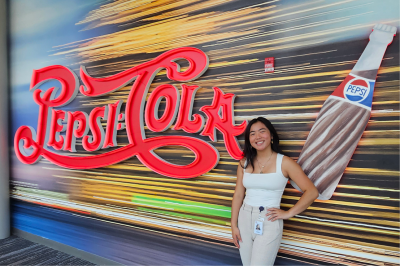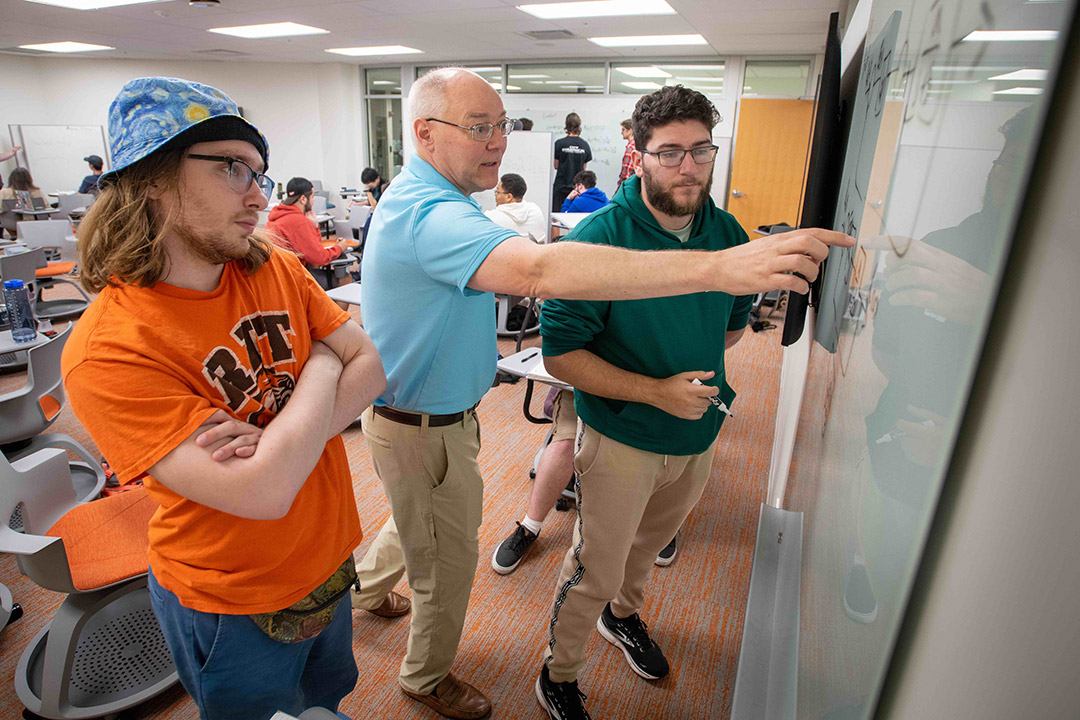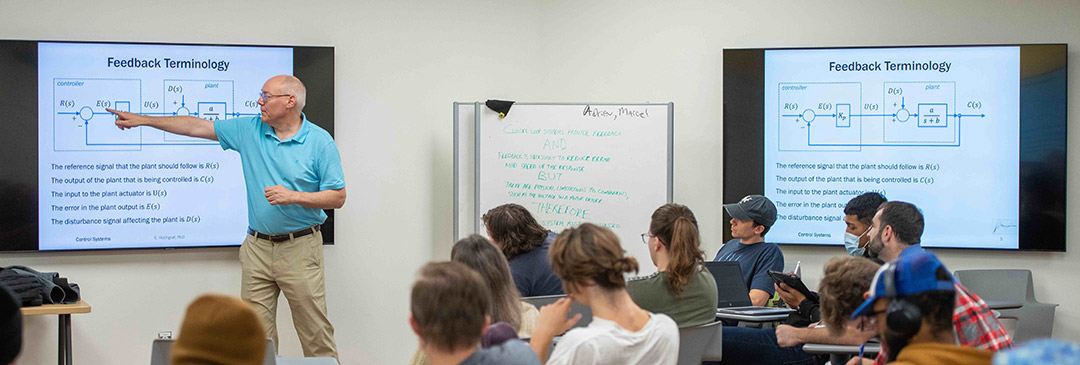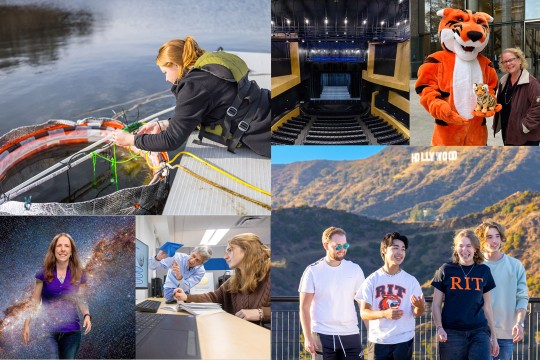Engineering technology faculty member uses ChatGPT as a modern ‘teaching assistant’
Clark Hochgraf integrates generative AI into courses as a necessary part of an engineer’s toolbox
Carlos Ortiz
Noah Andrulis, left, and Arben Geci, right, students in Clark Hochgraf’s control systems course, use one of the interactive classrooms in the Wallace Library.
Clark Hochgraf has been named the faculty associate for artificial intelligence in RIT’s College of Engineering Technology (CET). In his new role, the associate professor of electrical and computer engineering technology will assist CET faculty as they learn more about the capabilities of generative AI to improve student learning in courses.
Hochgraf is currently using generative AI in teaching Control Systems (EEET-427). An upper-level laboratory and lecture course, students learn to make mathematical models of systems, such as robots, then design embedded software to precisely control the movement of the system. Hochgraf is asking students to use ChatGPT in several ways—as a tool in their development of a control system, coding, and documentation. Another aspect is using ChatGPT as a learning guide, a resource they can direct questions to as they learn.
Since generative AI technology was first introduced, Hochgraf has explored its capabilities and refined how to effectively use the AI language models. Generative AI is a natural fit for the professor who has been involved in several applied research projects utilizing machine learning for intelligent warehouse automation. Integrating generative AI into classes is a powerful and necessary tool for engineers, said Hochgraf, who spoke recently about how he is encouraging more faculty and students in CET to use generative AI technology in the classroom as preparation for using it in the workplace.
As faculty associate of AI, how will this be formalized, and how will you work with faculty?
I will be doing a series of workshops on various aspects of using ChatGPT and similar tools. The aims of these workshops will be to normalize ChatGPT’s use and encourage faculty to share their successes and challenges. Through the history of our college, we have focused on helping learners learn. We have done things with active learning, within laboratory settings, with smaller class sizes. It is a natural thing for us to look at ChatGPT and ask how we can help our learners learn more effectively.
How are you using Chat GPT in your classes?
One of the big things with ChatGPT is asking students to be transparent—having them describe the prompts used, the outcomes they achieved, and to explain why a statement was paraphrased or challenged. Even the developers of AI are overwhelmed keeping up with this technology; it is improving exponentially. A resource we have as faculty members is the students. They are great at finding new ways to use things!
During the control systems class, I am asking students about their use. My role is helping students recognize that when they use generative AI, they must be specific in their prompts, provide more context, clarify intent, and then evaluate outcomes from a critical thinking perspective. This class is about interacting with physical systems—it either works or it doesn’t. You must have the physics, the equations, and circuits right. Students must write the code and de-bug the system. They have a lot of intellectual involvement. If the AI tools can help them understand the theory part, they can build more interesting systems that will work better. ChatGPT won’t help troubleshoot wires that are loose or in the wrong place, but there are so many other things that ChatGPT systems can help with.
What are your goals for your students?
If this experiment is successful in helping them learn and have a more effective understanding of this technology, they will be able to do more in the class. We’ll be able to take a class project and go further with it; we’ll be able to go into more advanced concepts. They will have more understanding and a higher level of retention beyond the class. If students are having this back-and-forth conversation with generative AI where they are sorting out the truth, that’s what they will remember.
Some see the challenges of using this AI language model. What is your approach to using ChatGPT?
Best case? ChatGPT will act as a friendly, non-judgmental teaching assistant at every desk, every single minute. That’s my approach. I look at ChatGPT and these language models as the tools of the engineer. These are the tools of the workplace. Although there will be some restrictions on them, we want students to learn about those restrictions—such as not submitting company information. We must help our graduates be efficient. We must help them avoid making the mistake of not being critical about information they get from a large language model. The way to do this is in the safe space of education. We can give them exposure to managing privacy risks and assessing the quality of the output, choosing the appropriate tasks and the most effective approaches. I’ve tried to take the very optimistic view — yes it has concerns. Those issues—bias, access, environmental uses—they are out there, they are real. I don’t minimize this, but remember, our students are using this technology. Let’s help faculty and students be effective using this, and the only way to address these issues is to air them out.
Carlos Ortiz
This fall, many faculty, including engineering technology Associate Professor Clark Hochgraf, are integrating ChatGPT into courses to ensure students can use the technology effectively for coursework and eventually in careers.







